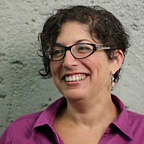Part 1: Intro to Founders’ Syndrome — When Patterns Last Too Long
- As a prospective hire, how do you see Founders’ Syndrome in a company?
- As a founder, what do you do to avoid or extricate yourself from Founders’ Syndrome patterns?
- And anyway… what is Founders’ Syndrome?
What is Founder’s Syndrome?
Founder’s Syndrome is yet another time that doing the very thing that got you where you are eventually turns out to be the problem keeping you from continuing.
By identifying and navigating the patterns as they form and how they show up too long, founders can create the best outcomes, and job seekers can enter certain situations with their eyes wide open (and know how to help).
How the elements of what later are referred to as “founders’ syndrome” begin?
Just think about how those workflows develop. Typically there is one person — maybe two people — who have a product idea, and they are going to move through (roughly) these stages: 💡 📄 💻 👨👩👧👦 🏁
Stage 1: 💡Product idea -> 📄 Prototype
Stage 2: 📄 Prototype -> 💻 MVP
Stage 3: 💻 MVP -> 👨👩👧👦 First users
These first 3 steps typically only support a small company, which has tight communications and strong leadership.
Stage 4: 👨👩👧👦 First users -> 🏁 Market-fit Foothold
Market-fit Foothold happens after you go through “the ten unicorn clients” if you have an enterprise product, or the first channel if retail… and I suppose Andreessen Horowitz is now coining “Market Annealing” as a name for the process.
That last step, finding market fit, can take years… and be excruciating!
CB Insights lists poor product-market fit as the #1 reason startups fail.
Core Competencies of Early Stage Startups
The most important thing to keep in mind is the core competencies that need to occur at the company.
Extremely fast feedback loops. “I’m talking with the client right now, can we do xyz by Q2?” Opportunities arise, and need to be acted upon immediately. Also, information must be shared promptly and clearly in all areas.
The time scales are still quite small. The product may be able to be planned out somewhat, but as the product-market fit isn’t established and the company isn’t profitable and operationally somewhat resilience, it’s very difficult to plan out more than a few months.
While product-market fit is searched for, and even after it is achieved, founders are at the center of everything, and because of the need for fast feedback and fast response, this is very often the most effective organizational structure and leadership style!
(I could digress here for other industries than tech, but if you look at how long it takes to make a new product and the investment in the product, you’ll see that tech is usually opposite things like “building a new type of submarine.”)
Also, while this is happening, the company is likely somewhere in the 20–200 employee range, so it’s quite reasonable for the founders to know everyone, and to be accessible enough to truly provide oversight.
Post- Product-Market Fit
Phase 5: 🏁 Market-fit Foothold -> 💰Post-fit Growth
After product-market fit, the organization matures in a new way:
- lowering risk
- expanding capacity
But.
That’s an incredibly hard shift that I just glossed over with a sentence.
Often seeking stability, finding product-market fit, getting clear of any risk to meeting payroll or having the runway suddenly shorten just when it seemed like stability was in reach… those are founder experiences that can be traumatic. I’m not exaggerating: these experiences, particularly when prolonged, can cause everything from professional doubts to home life instability and health problems.
Lowering Risk
One of the worst risks for a small company before it hits this stage is “key-person risk,” because quite a few roles are inhabited by one person, and even if cross-training is part of the culture, someone being out sick or “hit by a bus” (metaphor for “disappears suddenly”) can be a real crisis.
To lessen that risk, founders need to stop being at the center of workflows.
I hope you can see how changing from the pattern where the Founders are the ultimate arbiters and decision-makers to a structure of delegated responsibility is a major pattern shift!
Growth
Developing the structure to grow is the main post-fit transition. In the third and final post in this series I’ll touch on how founders can navigate this transition. In the next post, I’ll help job seekers find questions to ask to verify that the first regime isn’t held onto so long that it’s a confining growth and neglecting risk.
- Part 1: Introduction to Founders’ Syndrome (✳️ You Are Here)
- Part 2: Job Seekers As a prospective hire, how do you see founder syndrome in a company?
- Part 3: Founders As a founder, what do you do to avoid or extricate yourself from Founders’ Syndrome patterns?
— —
Jessica Margolin has been on several founding teams as well as being an early hire in tech, mHealth, and edTech. Her MBA is in Strategy & Org Development, and her MBA research was in the Center of Entrepreneurial Studies, regarding multi-stakeholder interpretations of “growth.”
